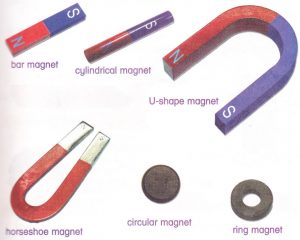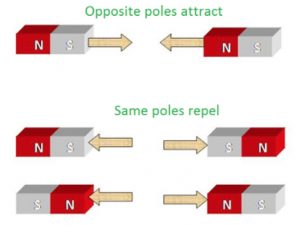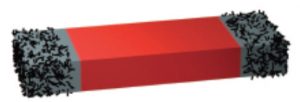Question 1 What are magnetic material? Give example?
Question 2 What are non-magnetic materials? Give example?
Question 3 A pencil sharpener gets attracted by both the poles of a magnet although its body is made of plastic. Explain?
Question 4 What name is given to the two ends of a magnet where the attraction is strongest?
Question 5 Name the two magnetic poles with attract each other?
Question 6 Name the two magnetic poles which repel each other?
Question 7 What is a magnet?
Question 8 Name different types of magnet?
Question 9 Of what materials are magnets usually made of?
Question 10 What is meant by poles of a magnet? Where are the poles of magnet located?
Question 11 Some iron nails and screws got mixed with the wood shaving. How will you help him in getting the nails and screws back from the wood?
Also Read NCERT Solutions for Chapter 13 Fun with Magnets
Magnet
A magnet is an object which attracts things made of iron, steel, nickel and cobalt. Magnets are made of iron, steel or other alloys of iron by the process of magnetisation. Magnets are made in different shapes and sizes so that they can be used for different purposes. A bar magnet is a long rectangular magnetised bar of iron or steel.
Some of the other types of magnets are horseshoe magnet, U-shaped magnet, cylindrical magnet (or rod magnet), button magnet and ring magnet.
Discovery of Magnet
Magnets were discovered by chance by an old shepherd named Magnes. He used to take his herd of sheeps and goats to a nearby mountain for grazing. He always took a wooden stick with him to manage his herd of sheep and goats. The wooden stick had an iron casing at its lower end. One day, Magnes suddenly felt that something was pulling his stick away from him. It appeared as if the iron covered end of stick was being attracted by a rock and got stuck to the rock. Magnes had to pull hard to free the iron end of stick from the rock. Actually, the rock was a natural magnet which attracted the iron end of Magnes stick. This rock which behaved like a magnet was given the name ‘magnetite. Magnetite rock contains iron.
The magnetite attracted pieces of iron towards itself. And when a thin strip of magnetite was suspended from a thread so that it could rotate freely, the magnetite strip always aligned itself in the same direction (north-south direction). One end of the freely suspended magnetite strip always pointed towards the north direction. Due to this property, the freely suspended mangetite strips were used by sailors in the ships to find directions in olden times (because they always pointed in the north direction). Since magnetite was used to find directions to lead the way for ships, it was also called ‘lode stone‘ (which means leading stone). The pieces of magnetite rock are known as natural magnets.
On the basis of their behaviour towards a magnet, all the materials can be divided into two groups: magnetic materials (which are attracted by a magnet) and non-magnetic materials (which are not attracted by a magnet).
Magnetic Material
Those materials which are attracted by a magnet are called magnetic materials. Iron, steel, nickel and cobalt are attracted by a magnet, so they are magnetic materials.The objects made of these materials like nails, paper clips, sewing needle, hair pins, paper pins, drawing pins, safety pins, knife blade, scissors, spade, blade, etc., are all attracted by a magnet. The objects made of nickel and cobalt metals are also attracted by magnets and hence they are also magnetic in nature.
Non-Magnetic Material
Those materials which are not attracted by a magnet are called non-magnetic materials. All the materials other than iron, steel, nickel and cobalt are non-magnetic materials.
For example : wood, plastic, rubber, paper, cloth, glass, leather, thermocol, copper, aluminium, brass, lead, stone, diamond, graphite, paint, charcoal, air, water, skin and bones, etc. are all non-magnetic materials (because they are not attracted by a magnet).
The objects made of non- magnetic materials are also non-magnetic in nature. Thus, a wooden spoon, a plastic scale, pencil, rubber, eraser, copper wire, aluminium can, brass utensils, a book, leather shoes, and wood shavings, etc. are all non-magnetic objects.
Non-magnetic materials cannot be magnetised. This means that non- magnetic materials cannot be converted into magnets.
(1) If a large number of pins from a pin box fall on the floor and get scattered, we can collect all the pins quickly by using a magnet (instead of picking up each and every pin by hand). So, if we move a magnet over the pins scattered on the floor, all the pins (being magnetic) will get attracted to the magnet and stick to it.
(2) Suppose a carpenter has mixed some iron nails and screws with lots of wood shavings while working. We can help him in getting back the nails and screws from the wood shavings by using a magnet. If we move a magnet through the wood shavings containing nails and screws, then the nails and screws (being magnetic) will get attracted to the magnet and stick to it. Wood shavings are non-magnetic and hence they do not stick to the magnet.
(3) A pencil sharpener gets attracted by a magnet though its body is made of a non-magnetic material called plastic. There is also a steel blade in the middle of sharpener. It is due to the presence of a steel blade (which is magnetic) in the middle of a sharpener that it is attracted by a magnet. Magnets attract only magnetic materials. Magnets do not attract non-magnetic materials.
Poles of a Magnet
If a bar magnet is put into a heap of iron filings, then the iron filings will cling to it or stick to it. The maximum amount of iron filings cling to the two ends of the bar magnet. The force of attraction of the magnet is the strongest near the two ends of the bar magnet. The two ends of the bar magnet are called Poles of the magnet.
The regions of a magnet where the attraction of magnet is the strongest are called poles of the magnet.The two poles of a magnet are near its free ends.The two poles of a magnet are always different. One pole of the magnet is called north pole and the other pole of magnet is called south pole. The North pole of a magnet is represented by writing the letter N near its one end. And the ‘South’ pole of a magnet is represented by writing the letter S near its other end .
The north pole and south pole of a magnet always exist together. Every magnet, whether big or small, has a north pole and a south pole. It is impossible to have a magnet having only one pole. Some force of attraction also exists in the middle part of the bar magnet but it is very small.
(i) The same type of magnetic poles are called like poles. For example: a North pole and another North pole’ are like poles. Similarly, a South pole’ and another South pole’ are also like poles. In other words, N and N poles are like poles. Similarly, S and S poles are like poles. Like magnetic poles repel each other.
(ii) The different types of magnetic poles are called unlike poles. For example: a North pole and a south pole are unlike poles. N pole and S pole are unlike poles. Unlike magnetic poles attract each other.
| Notes for Chapter 13 Fun with Magnets |



Thanx Shilpi Mam notes are quite easy to understand and very helpful.
Thankyou Maam. Well presented!!!
Video attachments will also help.